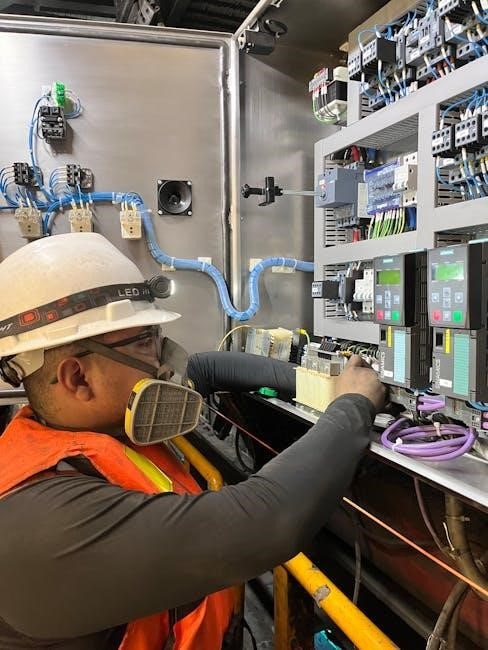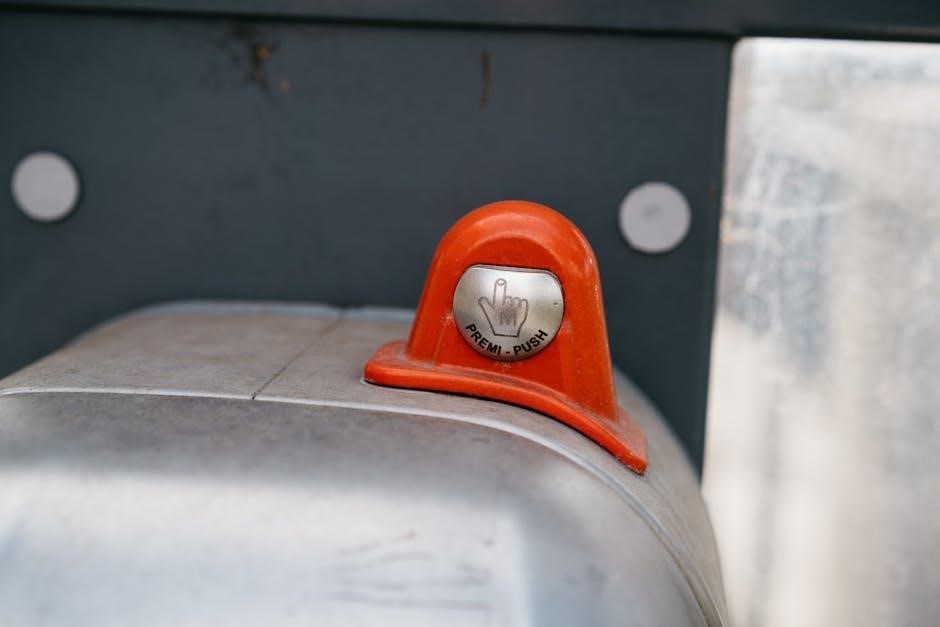Enhance your vehicle’s accessibility and safety with GM Factory Running Boards․ This guide provides step-by-step instructions for a successful installation, ensuring proper fitment and functionality while protecting against wear․
Overview of GM Factory Running Boards
GM Factory Running Boards are designed to provide durable, ergonomic support for easy vehicle access․ They feature a rugged construction with rust-resistant materials, ensuring long-lasting performance․ These boards are tailored to fit specific GM vehicle models, such as the Chevy Silverado and GMC Sierra, offering a seamless integration with factory-drilled mounting holes․ Key components include U-nuts, mounting brackets, and bolts, which ensure secure installation․ The boards are engineered to withstand harsh weather conditions and heavy use, making them a practical upgrade for both daily driving and off-road adventures․ With their sleek design and functional benefits, GM Factory Running Boards enhance both the convenience and aesthetics of your vehicle while maintaining factory standards for quality and reliability․
Importance of Proper Installation
Proper installation of GM Factory Running Boards is crucial to ensure optimal functionality, safety, and durability․ Misaligned or loosely secured boards can lead to structural damage, reduced stability, and potential safety hazards․ Correct installation prevents excessive wear on vehicle components and maintains the integrity of the running boards themselves․ By following factory torque specifications and using the correct hardware, you ensure a secure fit that withstands various driving conditions․ Proper installation also preserves the vehicle’s warranty and maintains its resale value․ It is essential to adhere to the provided instructions and guidelines to achieve a professional-grade installation, ensuring years of reliable performance and trouble-free operation of your running boards․

Preparation for Installation
Preparation for installing GM Factory Running Boards involves unpacking and organizing the kit, verifying all hardware, and ensuring your vehicle is ready for the process, including necessary tools and safety precautions․
Tools and Materials Needed

Installing GM Factory Running Boards requires essential tools like a socket set, wrenches, screwdrivers, and a torque wrench for precise bolt tightening․ The kit typically includes mounting brackets, U-nuts, bolts, and clips․ Additional materials such as gloves and safety glasses are recommended for safety․ Ensure a clean, well-lit workspace and refer to your vehicle’s manual for specific torque specifications․ Proper tools and preparation are crucial for a successful and safe installation, preventing potential damage or injuries․
Vehicle Inspection and Readiness
Before installing GM Factory Running Boards, inspect your vehicle to ensure it is ready for the process․ Check the rocker panels for any damage or debris that may interfere with mounting․ Verify that factory-drilled holes are present and undamaged; if they are not, you may need to drill new ones carefully․ Inspect existing hardware for rust or damage, as this could compromise the installation․ Position the vehicle on level ground and ensure it is secure․ Clean the rocker panels to ensure proper adhesion of U-nuts and clips․ Misaligned or loose bolts can lead to instability, so double-check all components before proceeding․ Proper vehicle readiness ensures a smooth and successful installation process․
Safety Precautions and Guidelines
Ensure a safe working environment by wearing gloves and safety glasses during installation․ Always lift the vehicle using jack stands for stability, and never rely solely on a jack․ Apply the parking brake and secure the wheels with chocks to prevent movement․ Avoid over-tightening bolts, as this can damage the vehicle or running board․ Properly ventilate the workspace to avoid inhaling dust or debris․ If drilling is required, use caution to avoid damaging surrounding components․ Keep loose clothing and long hair tied back to prevent accidents․ Follow the manufacturer’s torque specifications to avoid over-tightening, which could lead to damage․ Always double-check the stability of the vehicle before starting work․ Proper safety precautions ensure a secure and injury-free installation process․

Understanding the Hardware and Components
Understanding the hardware and components ensures proper installation․ Key parts include brackets, bolts, U-nuts, and clips designed to securely attach running boards to your vehicle․
Identifying Mounting Locations and Holes

To ensure a precise fit, locate the factory-designated mounting points on your vehicle․ These are typically pre-drilled holes along the rocker panels or frame, designed specifically for running boards․ Consult your GM factory instructions to confirm the correct positions, as misalignment can lead to improper installation․ Use the provided templates or diagrams to mark the spots accurately․ Clean the areas around the mounting holes to ensure a secure fit and prevent debris from interfering with the hardware․ Once the locations are identified, double-check the alignment before proceeding․ Proper identification of these points is crucial for a stable and functional installation․ Always refer to the torque specifications for bolts to avoid over-tightening or stripping threads․ This step ensures a safe and durable installation․
U-Nuts and Clips: Usage and Placement
U-Nuts and Clips are essential for securing GM factory running boards․ U-Nuts provide a strong grip on metal surfaces, while Clips help attach boards without drilling․ Proper placement ensures stability and functionality․ Align Clips with pre-drilled holes on the rocker panels or frame, following the manufacturer’s guide․ Tighten U-Nuts with a wrench or torque wrench to specified torque to avoid damage․ Ensure Clips are securely fastened to prevent shifting․ Use GM-recommended parts for compatibility․ Proper installation enhances safety and prevents hazards like loose boards․ Follow step-by-step instructions for correct placement, ensuring a stable attachment․ Double-check torque specifications and alignment for a secure fit․ This ensures reliable performance and vehicle safety․ Always refer to GM guidelines for accurate installation․
Factory-Drilled Holes and Torque Specifications
Factory-drilled holes are pre-installed by GM to simplify running board installation․ These holes ensure proper alignment and prevent damage to the vehicle․ Always use these holes to secure the mounting brackets, as they are specifically designed for this purpose․ Torque specifications are critical to ensure the bolts are tightened correctly․ Refer to your vehicle’s manual or the running board kit instructions for exact torque values․ Over-tightening can damage threads, while under-tightening may lead to loose brackets․ Use a torque wrench to achieve the recommended torque for a secure and durable installation․ Properly tightened bolts ensure the running boards remain stable and functional․ Always double-check torque specifications to avoid compromising the vehicle’s structural integrity․

Step-by-Step Installation Process
Follow a systematic approach to ensure a smooth and accurate installation․ Begin with unpacking and organizing components, then proceed with attaching brackets, securing hardware, and aligning parts․ Tighten all fasteners methodically to avoid missing steps․ Refer to the manual for precise guidance․ Maintain patience and attention to detail for a professional finish․ This structured method guarantees a secure and functional running board setup․ Always double-check each step before moving forward․ Proper sequencing ensures safety and durability․ Complete the process with a final inspection to confirm everything is correctly installed and aligned․ This step-by-step method ensures a flawless installation experience․
Unpacking and Organizing the Running Board Kit
Begin by carefully unpacking the GM factory running board kit to ensure all components are included and undamaged․ Inspect for any signs of shipping damage or missing parts․ Organize the components logically, such as separating brackets, running boards, hardware, and installation tools․ Use a checklist to verify the presence of all items, including bolts, U-nuts, clips, and mounting hardware․ Lay out the parts on a clean, flat surface to maintain visibility and accessibility․ Group similar hardware together, like bolts and washers, to streamline the installation process․ Refer to the included manual for specific guidance on identifying each component․ Once organized, double-check that all necessary tools and materials are within reach․ A well-prepared workspace ensures efficiency and reduces the risk of errors during installation․
Attaching Brackets to the Vehicle

Start by locating the mounting points on the vehicle, typically found beneath the rocker panels․ Clean the area to ensure a secure fit․ Align the brackets with the factory-drilled holes, ensuring proper orientation․ Use the provided hardware to temporarily secure the brackets in place․ Tighten the bolts by hand to hold the brackets, but avoid over-tightening at this stage․ Double-check the alignment to ensure the brackets are evenly spaced and properly positioned․ Once satisfied, use a wrench or socket to snug the bolts, following the torque specifications outlined in the manual․ This step ensures a stable base for the running boards․ Make sure the brackets are flush against the vehicle for optimal fitment and functionality․
Installing U-Nuts on the Rocker Panel
Begin by identifying the pre-drilled holes on the rocker panel where the U-Nuts will be installed․ Insert the U-Nuts into these holes, ensuring they are seated properly and aligned with the bracket mounting points․ Use a wrench or socket to tighten the U-Nuts securely, following the factory torque specifications to avoid over-tightening․ Double-check the alignment to ensure the U-Nuts are evenly spaced and flush with the rocker panel․ Once tightened, verify that the U-Nuts provide a stable anchor point for the running board brackets․ Proper installation of the U-Nuts is critical for the structural integrity and stability of the running boards․ Ensure the U-Nuts are snug but not overtightened, as this could damage the vehicle’s metal․ This step is essential for securing the brackets firmly in place․

Hanging the Front Bracket and Securing with Bolts
Once the U-Nuts are installed, carefully align the front bracket with the rocker panel, ensuring it fits snugly over the U-Nuts․ Gently hang the bracket in place, making sure it is properly seated․ Insert the provided bolts through the bracket and into the U-Nuts, then hand-tighten them to hold the bracket in position․ Use a wrench or socket to tighten the bolts in a star pattern to avoid misalignment․ Tighten to the factory-recommended torque specification to ensure a secure connection․ Double-check the bracket’s alignment and stability before moving on․ This step ensures the front bracket is firmly attached and ready for the running board installation․ Proper tightening is essential for long-term durability and functionality․
Aligning and Mounting the Running Board
After securing the front bracket, carefully lift the running board and align its mounting tabs with the pre-installed brackets on the vehicle․ Ensure the board is centered and evenly spaced for proper fitment․ Use the alignment marks or brackets as guides to position the running board correctly․ Once aligned, insert the mounting bolts through the tabs and into the brackets, then hand-tighten them․ Tighten the bolts in a star pattern to ensure even pressure and avoid warping the board․ Verify that the running board sits flush against the vehicle and is stable․ Double-check the alignment and spacing before proceeding to the next step․ Proper alignment ensures the running board functions as intended and maintains the vehicle’s aesthetics․
Tightening All Bolts to Factory Specifications
Once the running board is properly aligned and mounted, use a torque wrench to tighten all mounting bolts to the factory-specified torque value․ Refer to the owner’s manual or installation guide for the exact torque specification, as over-tightening may damage the vehicle or running board․ Tighten the bolts in a star pattern to ensure even pressure distribution and prevent warping․ Double-check each bolt to confirm it meets the torque specification․ Repeat this process for all bolts, including those on the brackets and U-nuts․ Properly tightened bolts ensure the running board remains secure, stable, and functional under various driving conditions․ This step is critical for both safety and durability of the installation․

Post-Installation Checks and Adjustments
After installing GM factory running boards, perform a visual inspection to ensure proper alignment and securement․ Check for any gaps or misalignment with the rocker panels, as this can affect both appearance and functionality․ Verify that all mounting brackets are securely fastened and that the running boards are evenly spaced․ Test the stability by gently stepping on them to ensure they feel sturdy and do not wobble․ Double-check that all bolts are tightened to the factory-recommended torque specifications to prevent damage or loosening over time․ Finally, inspect the overall appearance to ensure everything looks cohesive and functions as intended․ Address any issues promptly to ensure safety and longevity of the installation․
Verifying Proper Fitment and Alignment
After installation, carefully inspect the running boards to ensure they align perfectly with the vehicle’s rocker panels and body․ Check for any gaps or unevenness, as proper fitment is crucial for both functionality and appearance․ Measure the distance from the running board to the rocker panel on both sides to confirm symmetry․ Visually verify that the boards are straight and evenly spaced․ If necessary, adjust the brackets slightly to achieve proper alignment․ Use a level to ensure the running boards are horizontally aligned․ Test the fitment by gently pressing on the boards to ensure they feel secure and even․ Address any misalignment promptly to prevent damage or wear․ Proper alignment ensures optimal performance and longevity of the running boards․
Testing the Stability and Functionality
After installation, test the running boards by applying gentle to moderate pressure to ensure they are stable and firm․ Check for any wobbling or movement, which could indicate loose fasteners or misalignment․ Verify that the boards provide a solid stepping surface without excessive flex․ Inspect the load capacity by gradually applying weight, ensuring they can support the expected load without compromise․ Evaluate traction by testing them in wet conditions to ensure they remain slip-resistant․ Visually confirm that all components are securely attached and functioning as intended․ Address any issues promptly to maintain safety and performance․ Proper testing ensures the running boards meet both functional and safety standards effectively․
Final Tightening of All Fasteners
Once the running boards are properly aligned and mounted, perform a final tightening of all fasteners to ensure maximum stability and durability․ Use a torque wrench to tighten bolts and screws to the manufacturer’s specified torque values, which can be found in the GM factory instructions․ Tighten in a star pattern to prevent uneven stress on the mounting points․ Double-check all U-nuts, clips, and brackets to confirm they are securely fastened․ Inspect the entire installation for any loose or misaligned components․ Properly tightened fasteners ensure the running boards remain stable under various conditions and extend their lifespan․ This step is critical for both safety and performance, guaranteeing a reliable and long-lasting installation․

Troubleshooting Common Issues
Troubleshooting common issues during installation involves addressing misalignment, loose bolts, or improper hardware usage․ Always refer to the GM factory manual for specific solutions and guidelines․
Addressing Misalignment or Loose Bolts
Misalignment or loose bolts are common issues during installation․ Start by rechecking the bracket alignment with factory mounting points․ Ensure all bolts are tightened evenly to avoid uneven stress․ If bolts feel loose, re-tighten them gradually, following the torque specifications provided in the GM manual․ For misalignment, remove the brackets and reposition them carefully, ensuring they align perfectly with the mounting holes․ Double-check the hardware for proper placement, and verify that U-nuts or clips are securely fastened․ If issues persist, consult the factory instructions or contact GM support for additional guidance․ Proper alignment and tightness are critical for stability and durability․
Resolving Rust or Corrosion Concerns
Rust or corrosion on the vehicle or running board components can compromise the installation․ Inspect all surfaces for signs of rust before starting․ Clean rusty areas thoroughly with a wire brush or sandpaper and apply a rust-inhibiting primer or coating․ If corrosion is severe, replace the affected parts․ Ensure all hardware, such as bolts and U-nuts, is free from rust to maintain structural integrity․ Apply a protective coating to metal components after installation to prevent future corrosion․ Regular maintenance, including cleaning and inspecting the running boards, will help prevent rust from forming․ Addressing these issues early ensures a secure and long-lasting installation․
Successful installation enhances both functionality and aesthetics․ For further guidance, refer to GM’s official manuals or contact certified professionals for assistance and support․
Final Thoughts on Successful Installation
Proper preparation and precise alignment are critical for a seamless installation․ Ensure all bolts are tightened to factory specifications for optimal stability and durability․ Regular inspections and cleaning will maintain the running boards’ functionality and appearance․ For any uncertainties, consult the owner’s manual or contact GM-certified professionals․ Remember, a well-installed running board enhances both safety and aesthetics, providing years of reliable service․ Always follow manufacturer guidelines for maintenance and care to prolong the lifespan of your GM factory running boards․
Recommended Maintenance and Care Tips
Regular maintenance ensures longevity and optimal performance of your GM factory running boards․ Clean the boards with mild soap and water, avoiding abrasive cleaners that may damage the finish․ Inspect for rust or damage and address promptly․ Lubricate hinges periodically to maintain smooth operation․ Apply a clear sealant to protect the finish from environmental factors․ Check and tighten bolts every 6 months to ensure stability․ Avoid excessive weight on the boards to prevent damage․ For winter conditions, clean off salt and chemicals promptly to prevent corrosion․ Store cleaning products and tools nearby for routine upkeep․ By following these tips, you can enjoy durable and reliable running boards for years to come․ Regular care enhances both functionality and aesthetics․
Where to Find Additional Guidance or Support
For additional guidance or support during your GM factory running board installation, several resources are available․ Consult the official GM service manual or online support portal for detailed instructions and troubleshooting tips․ Many automotive forums and communities, such as GM-specific forums, offer firsthand experiences and advice from seasoned installers․ Local GM dealerships or certified mechanics can provide professional assistance if needed․ Additionally, video tutorials on platforms like YouTube often demonstrate step-by-step processes․ Ensure to verify the credibility of sources to align with factory specifications․ Reaching out to GM customer support directly can also yield official documentation or clarification on complex steps․ Always follow manufacturer guidelines for a successful and safe installation process․
